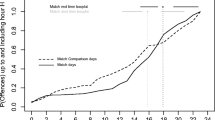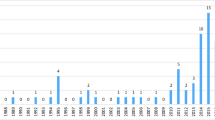Abstract
Spatiotemporal events occur in many disciplines, including economics, sociology, criminology, and seismology, with different patterns in space and time related to environmental characteristics, policing, and human behavior. In this paper, we propose a class of multivariate Hawkes processes with spatial covariates to consider the influence structure of spatial features in spatiotemporal events and the spatiotemporal patterns such as clustering. Baseline intensities are assumed to be a spatial Poisson regression model to explain spatial feature influence. The transfer functions are considered unknown but smooth and decreasing to explain the clustering phenomena. A semiparametric estimation method based on time discretization and local constant approximation is introduced. Transfer function estimators are shown to be consistent, and baseline intensity estimators are consistent and asymptotically normal. We examine the numerical performance of the proposed estimators with extensive simulation and illustrate the application of the proposed model to crime data obtained from Pittsburgh, Pennsylvania.


















Similar content being viewed by others
References
Adelfio, G., Chiodi, M. (2015). Alternated estimation in semi-parametric space-time branching-type point processes with application to seismic catalogs. Stochastic Environmental Research and Risk Assessment, 29(2), 443–450.
Bacry, E., Delattre, S., Hoffmann, M., Muzy, J. F. (2012). Scaling limits for Hawkes processes and application to financial statistics. Stochastic Processes and Their Applications, 123(7), 251–265.
Bernasco, W., Nieuwbeerta, P. (2004). How do residential burglars select target areas? A new approach to the analysis of criminal location choice. British Journal of Criminology, 45(3), 296–315.
Clauset, A., Woodard, R. (2013). Estimating the historical and future probabilities of large terrorist events. The Annals of Applied Statistics, 7(4), 1838–1865.
Clements, R. A., Schoenberg, F. P., Veen, A. (2012). Evaluation of space-time point process models using super-thinning. Environmetrics, 23(7), 606–616.
Daley, D. J., Vere-Jones, D. (2003). An introduction to the theory of point processes: Volume I: Elementary theory and methods. New York: Springer-Verlag.
Egesdal, M., Fathauer, C., Louie, K., Neuman, J. (2010). Statistical modeling of gang violence in Los Angeles. Society for Industrial and Applied Mathematics Undergraduate Research Online.
Eichler, M., Dahlhaus, R., Dueck, J. (2016). Graphical modeling for multivariate Hawkes processes with nonparametric link functions. Journal of Time Series Analysis, 38, 225–242.
Embrechts, P., Liniger, T., Lin, L. (2011). Multivariate Hawkes processes: an application to financial data. Journal of Applied Probability, 48A, 367–378.
Hawkes, A. G. (1971). Spectra of some self-exciting and mutually exciting point processes. Biometrika, 58(1), 83–90.
Kirchner, M. (2017). An estimation procedure for the Hawkes process. Quantitative Finance, 17(4), 571–595.
Lewis, E., Mohler, G. (2011). A nonparametric EM algorithm for multiscale Hawkes processes. Journal of Nonparametric Statistics, 1(1), 1–20.
Lewis, E., Mohler, G., Brantingham, P. J., Bertozzi, A. (2010). Self-exciting point process models of insurgency in Iraq. Security Journal, 25(3), 244–264.
Lewis, E. A. (2012). Estimation techniques for self-exciting point processes with applications to criminal behavior. PhD thesis, University of California, Los Angeles.
Liniger, T. J. (2009). Multivariate Hawkes processes. PhD thesis, ETH Zurich.
Marsan, D., Lengline, O. (2008). Extending earthquakes’ reach through cascading. Science, 319(5866), 1076–1079.
Mohler, G. O. (2013). Modeling and estimation of multi-source clustering in crime and security data. The Annals of Applied Statistics, 7(3), 1525–1539.
Mohler, G. O., Short, M. B. (2012). Geographic profiling from kinetic models of criminal behavior. SIAM Journal on Applied Mathematics, 72(1), 163–180.
Mohler, G. O., Short, M. B., Brantingham, P. J., Schoenberg, F. P., Tita, G. E. (2011). Self-exciting point process modeling of crime. Journal of the American Statistical Association, 106(493), 100–108.
Moller, J., Waagepetersen, R. P. (2003). Statistical inference and simulation for spatial point processes. London: CRC Press.
Ogata, Y. (1981). On Lewis’ simulation method for point processes. IEEE Transactions on Information Theory, 27(1), 23–31.
Ogata, Y. (1988). Statistical models for earthquake occurrences and residual analysis for point processes. Journal of the American Statistical Association, 83(401), 9–27.
Park, J., Schoenberg, F. P., Bertozzi, A. L., Brantingham, P. J. (2021). Investigating clustering and violence interruption in gang-related violent crime data using spatial-temporal point processes with covariates. Journal of the American Statistical Association, 116(536), 1674–1687.
Reinhart, A. (2018). A review of self-exciting Spatio-temporal point processes and their applications. Statistical Science, 33(3), 299–318.
Reinhart, A., Greenhouse, J. (2017). Self-exciting point processes with spatial covariates: modeling the dynamics of crime. Journal of the Royal Statistical Society, 67(5), 1305–1329.
Schoenberg, F. P. (2003). Multidimensional residual analysis of point process models for earthquake occurrences. Journal of the American Statistical Association, 98(464), 789–795.
Short, M. B., Mohler, G. O., Brantingham, P. J., Tita, G. E. (2017). Gang rivalry dynamics via coupled point process networks. Discrete and Continuous Dynamical Systems-Series B, 19(5), 1459–1477.
Tita, G., Ridgeway, G. (2007). The impact of gang formation on local patterns of crime. Journal of Research in Crime and Delinquency, 44(2), 208–237.
Veen, A., Schoenberg, F. P. (2008). Estimation of space-time branching process models in seismology using an EM-type algorithm. Journal of the American Statistical Association, 103(482), 614–624.
Vere-Jones, D. (1992). Statistical methods for the description and display of earthquake catalogues, Statistics in the Environmental and Earth Sciences (eds. A. T. Walden and P. Guttorp), 220–246, Edward Arnold, London.
Vere-Jones, D., Davies, R. B. (1966). A statistical survey of earthquakes in the main seismic region of New Zealand: Part 2-Time series analyses. New Zealand Journal of Geology and Geophysics, 9(3), 251–284.
Yuan, B., Schoenberg, F. P., Bertozzi, A. L. (2021). Fast estimation of multivariate spatiotemporal Hawkes processes and network reconstruction. Annals of the Institute of Statistical Mathematics, 73(6), 1127–1152.
Zhuang, J. C., Mateu, J. (2019). A semiparametric spatiotemporal Hawkes-type point process model with periodic background for crime data. Journal of the Royal Statistical Society Series A, 182(3), 919–942.
Zhuang, J. C., Ogata, Y., Vere-Jones, D. (2004). Analyzing earthquake clustering features by using stochastic reconstruction. Journal of Geophysical Research: Solid Earth, 109(B5), B05301.
Author information
Authors and Affiliations
Corresponding author
Ethics declarations
Funding
The first author was supported by the Applied Basic Research Programs of Shanxi Province (Grant No. 201901D211105). The second author was supported by the Fundamental Research Program of Shanxi Province (Grant No. 202103021223023).
Additional information
Publisher's Note
Springer Nature remains neutral with regard to jurisdictional claims in published maps and institutional affiliations.
About this article
Cite this article
Li, C., Cui, K. Multivariate Hawkes processes with spatial covariates for spatiotemporal event data analysis. Ann Inst Stat Math (2024). https://doi.org/10.1007/s10463-023-00894-2
Received:
Revised:
Accepted:
Published:
DOI: https://doi.org/10.1007/s10463-023-00894-2




